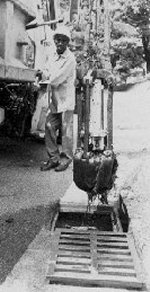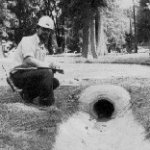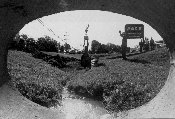Louisville and Jefferson County were facing a deepening dilemma in the mid-1980s: The core city had stopped growing, but urbanization was spreading. Louisville’s population had been declining since the mid-1960s. In the mid-1970s, the population of the county outside Louisville became more than the population of the city.
"Annexation wars" had thwarted many of Louisville’s attempts to expand — and had helped multiply the number of cities in the county. By the end of 1983, there were 96 — each with its own government, each with its own drainage responsibilities, some with their own sewer systems, and many with septic tanks.
Many community leaders said that merged metropolitan government would be the best way to consolidate vital services and provide for future growth. But the voters had turned down merger proposals repeatedly, most recently in 1982 and 1983.
By 1985, community leaders were working on a compromise solution. Louisville and Jefferson County officials began exploring ways that they could consolidate some programs and services, such as parks, the public library, the zoo, health care for the poor . . . and sewers and drainage. These negotiations would lead to the city-county compact of 1986.
In mid-1985, the Strategic Planning and Finance Committee recommended that MSD should take the lead in providing countywide drainage service, as well as sewer service. The problem, as always, remained financing. Technically, the city still owed MSD $1.25 million for drainage work completed in the 1970s, on the city’s promise to pay for the work once it had found a way to finance its drainage program. But the city had never found a way to pay for it. As a gesture of good will, MSD’s Board decided to let the matter rest while negotiations over a countywide drainage program continued.
The drainage proposal was returned to MSD’s Strategic Planning and Finance Committee to work out the details of how the program should be financed.

MSD Photo by Martin E. Biemer
The Plan For The Future
By October, 1985, most of the committee’s initial work had been completed. The final step, before adopting a plan, would be a series of eight public meetings — four in Louisville and four in suburban areas — to explain the details and ask for suggestions.
The recommendations, in brief, were to:
- Continue expanding the sanitary sewer system, with the goal of eliminating septic tanks and small treatment plants;
- Provide more flexible financing plans for homeowners getting new sewers, including financial assistance for those with low incomes;
- Repair the older sewer lines in the system, especially those that were more than 100 years old, and set up an ongoing inspection and maintenance program for all sewer lines;
- Take the lead in establishing a coordinated, countywide drainage program.
The first four public meetings were held simultaneously on November 20th, attracting a total of about 450 people. At Fairdale, Fern Creek and Pleasure Ridge Park high schools, the main concern was drainage. At Ballard High School, the main concern was extending the sewers to eliminate septic tanks and small plants — but in the southwestern part of the county, there was still vocal opposition to "forced sewers."
About 70 people showed up at the public meetings December 4th at Atherton, Central and Iroquois High Schools and the Youth Performing Arts School. The main concerns were drainage problems, followed by the condition of the city’s old sewer lines.
In general, the comments at the meetings reflected to opinions expressed in the survey the year before — and showed that the public was eager to have something done about community sewers and drainage problems.
On December 23rd, the MSD Board approved the Strategic Planning and Finance Committee’s recommendations, which would become a blueprint for action for the rest of the century.
And on New Year’s Eve, a Courier-Journal editorial praised the plan and MSD’s leadership, saying, in part:
"As recently as 1982, Jefferson County’s long-studied sewer expansion program was in shambles, a victim of rising costs, federal foot-dragging and citizen resistance. Now, these roadblocks have mostly been removed by (the) plan approved last week."
"It is a balanced political, financial and environmental package that should spell success because it has something for almost everyone. Sewers will be expanded to areas where development has been stymied. Existing sewer lines will be repaired. Drainage projects should improve life in some neighborhoods."



MSD Photos by Martin E. Biemer
The Drainage Program
The drainage program’s development during 1986 became a classic example of the political process in action to overcome obstacles to meet a widely recognized public need.
The first step was to ask the legislature to pass a law forming a countywide drainage utility. That step failed with a tie vote in the House of Representatives on the last day of the legislative session.
Seeking alternatives, city and county officials joined with MSD in researching the law, and found that the drainage program could be formed by using the city-county compact process that the legislature had approved.
In May, the MSD Board approved a $991,000 study of countywide drainage needs. And in June, the Board approved the basic countywide plan, with details still to be worked out.
The following months brought the compromises that helped resolve major issues:
- Financing would be handled through a drainage user fee based on the "impervious area" (pavement, roofs, etc.) on a property. Single-family residences would all be charged the same rate — eventually set at $1.75 per month — and commercial and industrial properties would be charged $1.75 per month for each 2,500 square feet of impervious area. MSD pledged that the rate would not be increased for five years.
- The fee would be considered as a public utility service charge, similar to sewer, water, gas, electricity and telephone service charges; government agencies would pay it, as well as schools and non-profit organizations.
- The urbanized and developing areas of the county would be included, but not the farmland in the outer reaches.
- Third and fourth-class cities would be given the option of joining the program, or continuing to handle their own drainage. (As the program developed, five suburban cities decided to keep their own drainage programs: Anchorage, Jeffersontown, St. Matthews, Shively and Prospect. All others joined the new program.)
- Operation and maintenance of the Ohio River floodwall system would be included, freeing the city and county of this responsibility.
- Priorities were set for 52 most-needed drainage projects, in all parts of the new drainage service area, to be financed by a $25 million bond issue.
By early December, the details had been worked out. The formal actions creating the new program were completed on December 23rd.
The program began January 1, 1987, but not without opposition. In a development that harked back to MSD’s earliest days, several groups went to court to challenge the new drainage fee. MSD was allowed to collect the fee while the court case was pending, but the challenge delayed the $25 million bond issue and the 52 major projects it was designed to finance. The challenge finally ended in June, 1989, when the Kentucky Court of Appeals ruled in favor of the program.
To explain the new program and gather information on problems, MSD scheduled more than 150 public neighborhood meetings from late 1986 through 1987. The meetings and the publicity helped bring in thousands of requests to solve drainage problems, in addition to the 1,500 requests MSD inherited from the city and county. While MSD was able to resolve most of these requests, the backlog kept growing. The court challenge delayed construction of the 52 priority projects for more than three years. In the meantime, the income from the drainage fee financed a larger maintenance program — and allowed construction of dozens of smaller drainage projects to serve individual streets and neighborhoods.
MSD History continued - Sanitary Sewer Expansion


